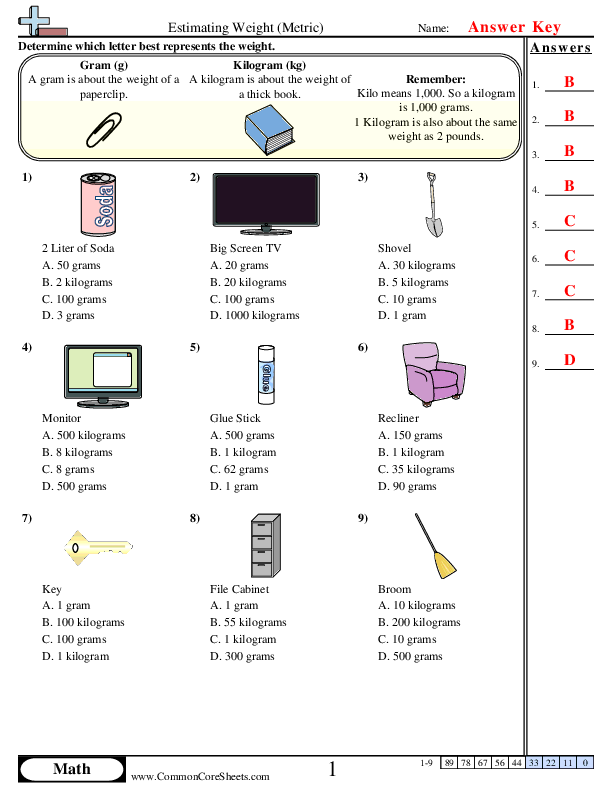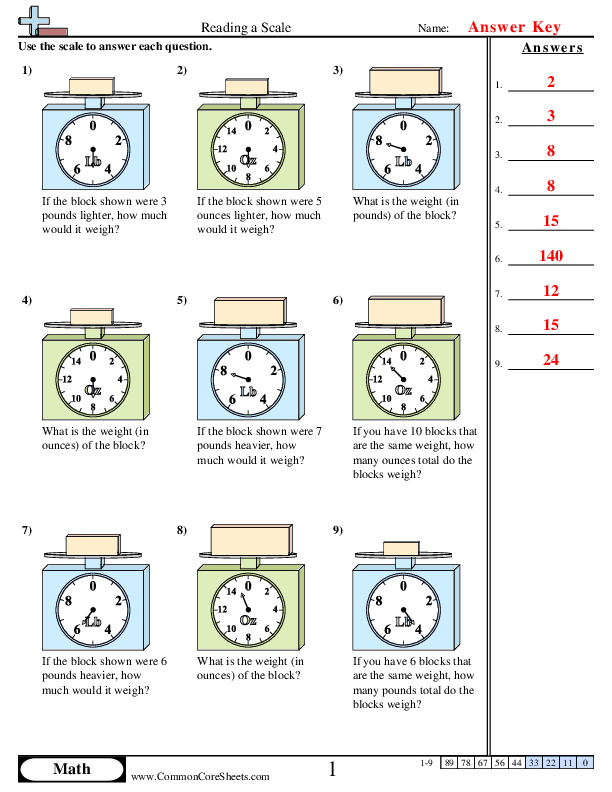Sort By Grade
Measurement and Data
Solve problems involving measurement and estimation of intervals of time, liquid volumes, and masses of objects.
2Measure and estimate liquid volumes and masses of objects using standard units of grams (g], kilograms (kg], and liters (l). Add, subtract, multiply, or divide to solve one-step word problems involving masses or volumes that are given in the same units, e.g., by using drawings (such as a beaker with a measurement scale) to represent the problem.
3md2

Metric Capacity (visual)
3md2


×
Description:
"This worksheet is designed to help children understand the concept of estimating capacity in metric units. Featuring nine engaging problems, children will estimate the capacity of objects like a cereal bowl, bathtub, and the sand a wheelbarrow holds. Is it 1 milliliter or 500? The worksheet is versatile and can be easily customized for all learning levels, converted into flash cards, or utilized in distance learning. It's a fun and practical way to reinforce math skills at home or in the classroom."

×
Student Goals:
Understand and Apply Capacity ConceptsUpon completion of the worksheet, students should have a clear comprehension of capacity and its application in real-life scenarios. They will learn how to estimate the capacity of various containers and substances, fostering their practical measurement abilities. The practical problems presented on the worksheet would help children develop a strong understanding of metric units such as milliliters and liters, and when to use each appropriately.Enhance Numerical ProficiencyThe worksheet will facilitate the enhancement of students' quantitative ability as they engage quantitatively with the real world. By comparing and identifying correct numbers for the various problems, students will not only hone their mathematical skills but also develop their critical thinking, reasoning, and decision-making abilities.Apply Knowledge to Real-life ContextsBy estimating the capacity of everyday items like a bottle of shampoo or a pitcher of liquid, students will learn the applicability of their mathematical knowledge. This reinforces the lesson that math is not merely abstract numbers but a useful tool in understanding and navigating the everyday world. The worksheet helps children make connections between their classroom learning and its relevance to the world around them.Develop Problem-Solving SkillsTackling the problems in the worksheet requires students to deploy strategic thinking and problem-solving skills. As they sift through different options to find the correct answer, they exercise their ability to analyze, evaluate, and deduce. This worksheet thus aids in the development of logical reasoning and problem-solving skill which are essential in various aspects of life and career.Boost Confidence in Understanding Capacity-Related ProblemsSuccessfully solving the problems in the worksheet can help students gain confidence in their understanding of capacity-related scenarios. This confidence can translate into improved performance not just in math, but in other subjects and general learning too. By being engaged and challenged, students feel accomplished, boosting their overall morale and confidence in learning.



Metric Capacity (word)
3md2


×
Description:
"This worksheet is designed to enhance children's math skills by estimating capacity using metric measurements. It contains 15 engaging problems prompting kids to differentiate between milliliters and liters in practical scenarios. Customizable for individual learning needs, it can also be converted into flash cards for revising purposes, and is suitable for distance learning sessions. A great tool for learning metric units of volume effectively."

×
Student Goals:
Understanding of Capacity EstimationsUpon completing the worksheet, students should have a good understanding of the concept of capacity and be able to estimate the probable capacity of everyday objects and situations in real life. They should be able to effectively differentiate between milliliters and liters and grasp the magnitude of each unit of measurement, exhibiting a significant improvement in their numeracy skills.Enhancement in Problem SolvingThrough engaging with these capacity-related problems, children will develop their critical thinking and problem-solving skills. They will learn how to infer information from given contexts and apply their mathematical knowledge to estimate and judge the capacity of different scenarios, drastically improving their logical reasoning abilities.Integrating Math Knowledge with Everyday SituationsStudents will be able to take their learned math principles and integrate them into everyday scenarios. The capacity estimation problems represented in the worksheet are based on common household items and actions, thus the exercise highlights the use of mathematical concepts in their routine, enhancing their contextual understanding of measurement units.Boost in Analytical skillsDetermining whether the capacity of an item is closer to certain milliliters or liters will challenge the students’ analytical skills. As they practice, their capability to swiftly and accurately make such judgments should improve, providing a boost in their analytical skills that can be applied in various situations beyond mathematics.Confidence in Decision MakingBy continuously estimating and deciding between two given units, students will gain confidence in their decision-making abilities. This task will allow them to trust their own judgments and make decisions independently, thereby fostering an increase in their self-confidence and autonomy.Understanding of Practical Applications of MathThe worksheet will enhance students' understanding of the practical applications of mathematics. They will learn to appreciate how the math concepts they learn in the classroom pervade everyday life, demonstrating the real-world utility of their classroom learning, and inspiring them to seek out more practical applications of their knowledge in the future.Progress in Metric ComprehensionStudents will make substantial progress in their metric comprehension skills. As they learn to estimate the magnitude of various quantities in liters and milliliters, they will improve their understanding of metric units. In the process, they will also gain a clearer sense of the ordinality and patterning of numbers in the metric system.



Estimating Weight
3md2


×
Description:
"This worksheet is designed to enhance children's understanding of the metric weight system. It includes nine math problems asking students to estimate the weight of common objects, making abstract concepts tangible. Content, flexible in nature, can be customized to suit individual learner's needs, converted into flashcards for interactive learning, or incorporated into distance learning curricula. An effective tool bridging the gap between classroom concepts and real-world applications."

×
Student Goals:
Understanding Measurement UnitsUpon completion of this worksheet, students should be able to recognize and understand the use of different units of measurement in the metric system, specifically grams and kilograms. This foundational knowledge is critical in their mathematical journey, as the metric system is extensively used across various fields such as science, engineering and everyday life.Estimation SkillsStudents will have developed their estimation skills — an important mental math tool allowing them to make swift, reasonable approximations on the weight of different common objects. This can be useful in numerous real-world scenarios, helping them to make quick decisions or judgments when precise measurements are not necessary or available.Problem-solvingWith practice from the worksheet, students will have sharpened their problem-solving abilities. This skill is not only crucial in mathematical assignments and tests, but also in day-to-day tasks and challenging situations. By carefully examining, analyzing the options and making a calculated decision, students learn how to respond to different problems effectively.Knowledge ApplicationCompletion of the worksheet will mean the students have effectively applied their knowledge of metric units in a practical, real-world context. This application of theoretical learning will enhance the students' understanding of metric units and how they are used to estimate weights of everyday objects.Critical ThinkingThrough this worksheet, students will improve their critical thinking skills by choosing the most plausible answer from several options. By comparing and contrasting different options, they improve their ability to think logically and rationally, skills that are necessary across many disciplines.Concept ReinforcementCompleting this worksheet will reinforce the students' understanding of metric weights in terms of grams and kilograms, and assist in solidifying their understanding of the distinction between these units. This is paramount in ensuring students do not confuse these units in future mathematical applications.



Reading a Scale
3md2


×
Description:
"This worksheet is designed to improve children's understanding of weight measurements in both pounds and ounces through nine mathematical scenarios. It provides a customizable and engaging approach to learning, with the option to convert the exercises into flash cards. With its digital format, it is highly suitable for both classroom teaching and distance learning, facilitating the comprehension of scale reading in a practical context."

×
Student Goals:
Understanding WeightsUpon completion of the worksheet, students should have a good understanding of weights and how they can change. They will know how to read scales to determine the weight of various objects and understand the difference between ounces and pounds. This is a foundational knowledge required for more advanced mathematical problems.Adding and Subtracting WeightsThe worksheet helps students cultivate abilities such as addition and subtraction of weights. This involves comprehending how much a block would weigh if it were lighter or heavier by a certain amount, an essential skill in practical applications like cooking or shopping.Measurement ConversionStudents will gain proficiency in converting units of weights, like pounds into ounces and vice versa, another frequently used skill in daily life. Such practice also advances their basic math skills and enhances their precision in measurement.Problem SolvingThrough tackling a variety of weight-related problems, students will develop their problem-solving skills. This includes not just the application of mathematical concepts but also the ability to logically and systematically approach the problems. They will learn to visualize a problem, outline a strategy to solve it, and execute the strategy.Multiplication ConceptsStudents will also grasp basic multiplication concepts after finishing this worksheet. They will understand how to calculate the total weight of multiple blocks given the weight of one block. This skill is again a fundamental building block for many advanced math concepts.





